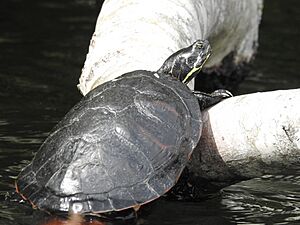Northern red-bellied cooter facts for kids
Quick facts for kids Northern red-bellied cooter |
|
|---|---|
 |
|
| Conservation status | |
| Scientific classification | |
| Genus: |
Pseudemys
|
| Species: |
rubriventris
|
| Synonyms | |
|
|
The northern red-bellied turtle (Pseudemys rubriventris) is also known as the American red-bellied turtle. It is a type of turtle that belongs to the Pseudemys group, also called cooters. These turtles are part of the Emydidae family.
This turtle is a fairly large river turtle. It usually grows to be about 29 to 30 centimeters (11 to 12 inches) long. On average, it weighs around 3 kilograms (6.6 pounds). However, some large female turtles can grow up to 40 centimeters (16 inches) long.
Contents
Where They Live
This turtle only lives in the United States. You can find the northern red-bellied turtle in Massachusetts. Scientists once thought the turtles in Massachusetts were a special kind of red-bellied turtle. Their home also includes coastal areas of New Jersey, Pennsylvania, Delaware, Maryland, Virginia, and North Carolina.
Why They Need Our Help
The northern red-bellied turtle is a species that needs protection. Since 1978, this turtle has been on Pennsylvania's list of endangered animals. By 1985, only small groups of them, fewer than 30 turtles, were found in a few places in Pennsylvania. These places included Manor and Silver lakes in Bucks County. They were also found in the Tinicum wetlands in Philadelphia and Delaware counties. Other spots were the West Branch of Conococheague Creek in Franklin County and possibly Springton Reservoir in Delaware County.
The turtle is listed as "threatened" in Pennsylvania. But the US Fish and Wildlife Service and the Division of Fisheries and Wildlife (Massachusetts) list it as "Endangered." This means it is at high risk of disappearing forever.
Threats to Their Survival
Many things can harm northern red-bellied turtle populations. Here are some of the main problems:
- Losing Wetlands: The places where they live, like wetlands, are being destroyed.
- Broken Homes: Their habitats are being split up, making it hard for them to move around.
- Pollution: Water and land pollution can make them sick.
- Collecting: Some people take turtles from the wild to keep as pets.
- Competition: An invasive turtle called the Red-eared slider competes with them. They fight for food, homes, sunny spots to warm up, and places to lay eggs.
- Mixing Species: There is a chance that red-bellied turtles could breed with red-eared sliders. This could change the unique features of the red-bellied turtle.
Helping the Turtles
Good news! People are working to help these turtles. The Massachusetts wildlife preserve foundation has started to help the turtles grow their numbers again. They are placing them in many ponds in southeastern Massachusetts. For example, at Long and Little Long Pond in Plymouth, Massachusetts, the turtle population is starting to get bigger.
Images for kids




